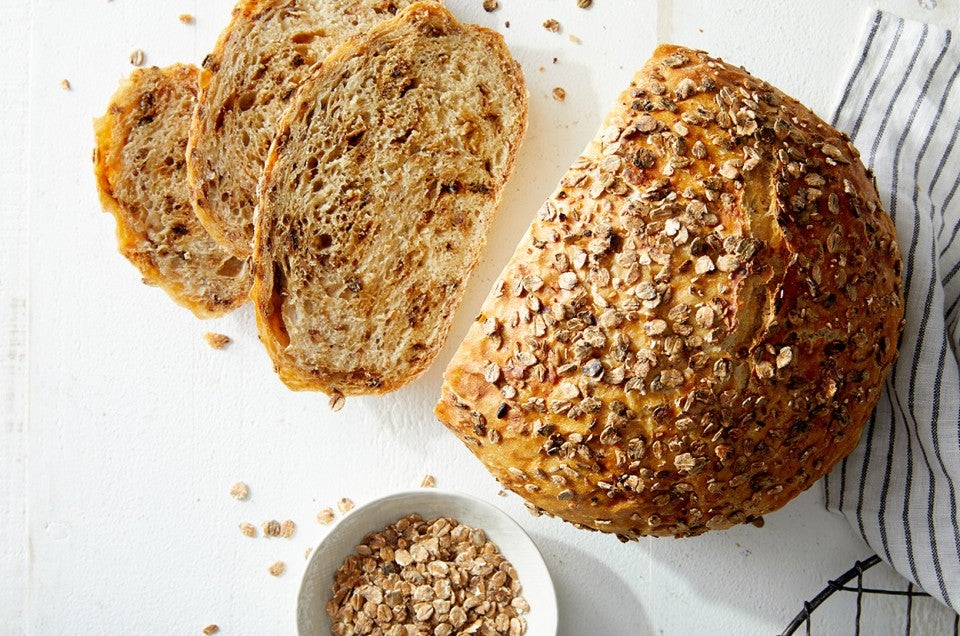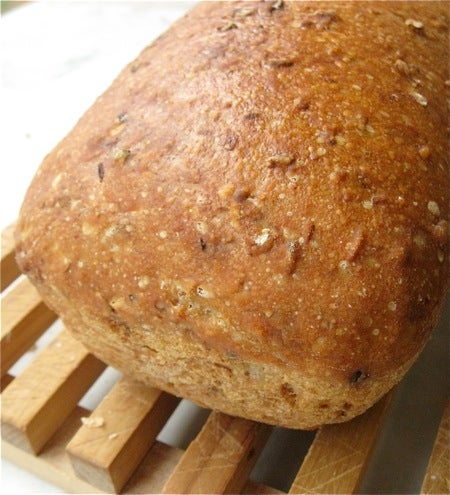


Crusty.
Chewy.
Whole-grainy.
If you're a fan of these three yeast-bread characteristics, you're going to LOVE this loaf!
Malted wheat flakes (wheat berries slow-baked to bring out their sugars, then sliced and flattened) are a key ingredient. They add nubbly texture and a subtle touch of caramelized sweetness to the bread.
Can you substitute traditional rolled oats? Sure; but you'll lose that distinctive flavor and texture, as oats will simply blend right into the loaf, rather than add the very slight crunch characteristic of malted wheat flakes.
My suggestion? Spring for the malted wheat flakes.
What makes whole-grain breads rise, and gives them delightfully chewy texture? That would be our highest-protein flour: High-Gluten Flour, checking in at 14.2% protein (compared to our bread flour, at 12.7%; and our all-purpose flour, at 11.7%).
Malted wheat flakes are a classic British ingredient, key in their Granary Bread. Crunchier and darker than rolled oats, and slightly sweet, they can be used in place of oats in many recipes.
OK, let's get started.
Put the following in a bowl:
3 cups (360g) High-Gluten Flour or King Arthur Unbleached All-Purpose Flour
2 cups (226g) King Arthur Golden Wheat Flour
1 cup (113g) malted wheat flakes
2 1/2 teaspoons (15g) salt
1 teaspoon instant yeast
2 1/4 cups (510g) cool water
Stir, then use your hands (or a stand mixer) to mix up a sticky dough.
Continue to work the dough enough to incorporate all the flour, or beat for several minutes in a stand mixer.
Scrape the sticky dough into the center of the bowl; pick it up (a dough scraper is a big help), spray the bowl with non-stick vegetable oil spray, and lay the dough back in the bowl. If you need your mixing bowl for other things, put the dough in a lightly greased container.
Cover the bowl, and let the dough rest at room temperature for about 8 to 16 hours; overnight is fine.
It'll become bubbly and rise quite a bit, before falling back; so be sure your bowl is large enough.
Look at that gluten at work - it's a beautiful thing! You never kneaded this dough, but the long, slow rise allowed the gluten to develop on its own.
Turn the dough out onto a lightly floured surface.
To make a single loaf, choose a 14" to 15" long covered baker; a 9" x 12" oval deep casserole dish with cover; or a 9" to 10" round bread baking crock. Spray your chosen pan with non-stick vegetable oil spray; Everbake is our favorite.
To make two loaves, lightly grease (or line with parchment) a large baking sheet.
Shape the dough to fit the pan.
For two loaves, divide dough in half, shape each into an oval loaf, and place on the prepared baking sheet.
Nestle the dough into the pan, patting it into the corners.
Cover and let rise at room temperature for about 1 hour.
The dough will become puffy, and will fill the pan about 3/4 full.
If baking in a lidded crock or pan that directs you to place the pan in a cold oven, place the pan in the oven, set the oven temperature to 450°F, and bake the bread for 45 to 50 minutes.
Remove the lid and continue to bake for another 5 to 15 minutes, until the bread is deep brown, and an instant-read thermometer inserted into the center registers about 205°F.
To bake in a pan that doesn't require starting in a cold oven, preheat the oven to 450°F, and bake for about 45 to 50 minutes, removing the lid of the pan after 30 minutes.
For two loaves on a baking sheet, bake in a preheated 450°F oven for 35 to 40 minutes, until bread is a deep, golden brown, and the center registers about 205°F.
The finished loaf will be a deep, golden brown. This loaf decided to shred on its own, meaning I probably should have slashed it before putting it into the oven. Live and learn. No problem; looks don't affect taste.
See the crust's soft sheen? That's from baking the bread in a covered baker. Moisture from the loaf's interior migrates out and is captured in the baker, where it becomes steam. And steam reacts with the starch in flour to create shine.
It's hard, but please wait till it's cooled to slice; slicing hot bread tends to make it gummy. Patience is a virtue!
Read, rate, and review (please) our recipe for Malted Wheat Flake Bread.




















